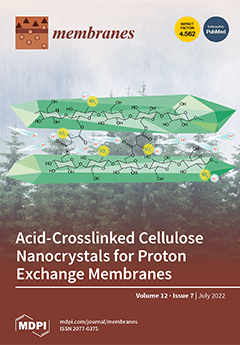The purification of hydrogen (H
2) has been a vital step in H
2 production processes such as steam–methane reforming. By first-principle calculations, we revealed the potential applications of holey TMC
6 (TM = Mo and W) membranes in H
2 purification.
[...] Read more.
The purification of hydrogen (H
2) has been a vital step in H
2 production processes such as steam–methane reforming. By first-principle calculations, we revealed the potential applications of holey TMC
6 (TM = Mo and W) membranes in H
2 purification. The adsorption and diffusion behaviors of five gas molecules (including H
2, N
2, CO, CO
2, and CH
4) were compared on TMC
6 membranes with different phases. Though the studied gas molecules show weak physisorption on the TMC
6 membranes, the smaller pore size makes the gas molecules much more difficult to permeate into h-TMC
6 rather than into s-TMC
6. With suitable pore sizes, the s-TMC
6 structures not only show an extremely low diffusion barrier (around 0.1 eV) and acceptable permeance capability for the H
2 but also exhibit considerably high selectivity for both H
2/CH
4 and H
2/CO
2 (>10
15), especially under relatively low temperature (150–250 K). Moreover, classical molecular dynamics simulations on the permeation process of a H
2, CO
2, and CH
4 mixture also validated that s-TMC
6 could effectively separate H
2 from the gas mixture. Hence, the s-MoC
6 and s-WC
6 are predicted to be qualified H
2 purification membranes, especially below room temperature.
Full article






